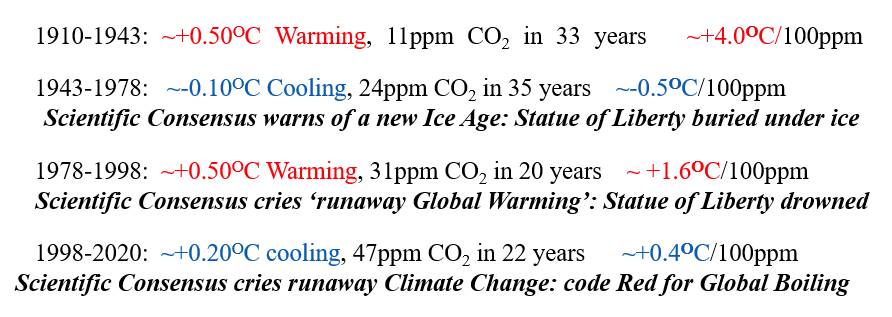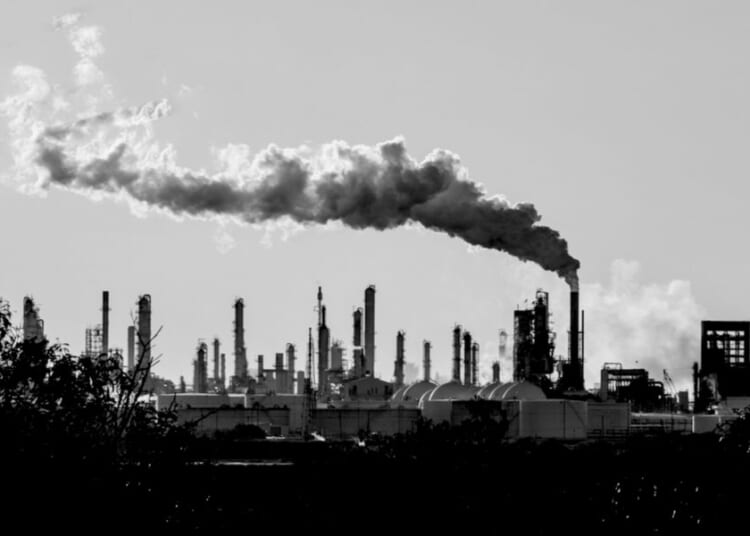THE only way to stop the planet ‘boiling’ is to cut emissions, we are told by the International Panel on Climate Change (IPCC), the UN, the state-run weather forecasters, the universities and the western ‘Learned Societies’, because that’s what the climate models tell them. The best way to cut emissions, they say, is to replace all fossil fuel use with those glorious renewables. Why? Because they don’t have a carbon footprint.
Yet despite promises to begin cutting emissions at some time in the future, China, India, and Indonesia and other so-called developing nations, as well as Russia, Japan and now Argentina, all seem to have realised that neither assertion is true. They are building far more coal-fired energy plants than the guilty Western governments are closing.
This presents a problem for the IPCC’s claim. Nevertheless, they try to maintain the charade that it is true, bolstering this partly by their misleading method of reporting of CO2 data.
We are told and we agree that atmospheric CO2, currently around 420ppm (the number of carbon dioxide molecules per million molecules of dry air), is increasing. What we do not agree on is that it is due mainly to CO2 emissions from fossil fuels, which in 2022 were reported by BP as 34,374million tons. But how on earth are we to make sense of these two numbers, which is rather worse than comparing apples and oranges? Surely it would be simpler to have both quantities in the same units, particularly since this is easily done. Emitting 7,800million tons of CO2 adds just 1ppm to the atmosphere, so the heavy weight of emissions added to the atmosphere in 2022 becomes just 4.4ppm of CO2. That wasn’t so difficult, was it?
Australia’s emissions in the same year were 376million tons, which is 1 per cent of the global total, and just 4.8 per cent of 1ppm. Even if Australia cut all its CO2 emissions (which can’t be done), the atmosphere wouldn’t notice, particularly as Asia’s average annual increase in emissions is more than Australia’s slowly declining annual total.
It gets more interesting; the IPCC correctly note that, on average, 50 per cent of human CO2 emissions are naturally sequestrated/absorbed by the biosphere and oceans, which explains why atmospheric CO2 as recorded at Mauna Loa in Hawaii increased during 2022 by just 2.1ppm, compared with the 4.4ppm emitted. What is going on here? If only half of human emissions remain in the atmosphere, and if the world is to reduce atmospheric CO2 by 1ppm, global emissions would need to be reduced by 2ppm, or 15,600 million tons, some 41 times Australia’s total output. Again, how will that be achieved if Asia continues to build more and more coal mines and coal-fired power stations?
This difference between annual emissions and atmospheric concentrations is a quandary which casts doubt on the optimistic thinking behind the much-vaunted idea of carbon capture and sequestration/storage (CCS). Taking 1ppm out of the atmosphere requires that we capture, compress and inject 2ppm of emissions into the earth, every year, for ever. This is a herculean task well beyond our resources, for 2ppm or 15,600 million tons of CO2 is, in volumetric terms, more than double the total amount of natural gas produced globally in 2022. Just imagine, shutting down every gas well in the world and converting them into CCS injectors just to bury 1ppm per year, then drilling and completing the same number of wells to get to 2ppm.
A CCS trial project is being evaluated in Queensland, where miner Glencore will be injecting 100,000 tons of CO2 for three years into a sandstone reservoir 7,500ft below ground level. That is just a third of a million tons over three years, so how many wells would be needed to inject the 15,600million tons per year needed to get 2ppm safely stored away underground, every year, for ever?
Even if we accept that the cost of such an exercise is ‘the price we have to pay to save the planet’, CCS is not going to do anything to reduce atmospheric CO2 significantly and, unlike nuclear waste, CO2 does not have a half-life.
We must not forget that the prime villain in this story is the approximately 140ppm that the IPCC claim to be conclusively attributed entirely to humanity’s pursuit of technological innovation and a more comfortable lifestyle – in the West. So getting to Net Zero does not mean removing all of the 420ppm currently in the atmosphere, but the IPCC are very shy about telling us what will produce the best, most pristine atmosphere – is it a very low, pre-industrial 280ppm, or is it 350ppm, or 372.543ppm . . ? Perhaps they are truly unaware that the only demonstrably measurable result of increasing atmospheric CO2, has been the steady increase in crop yields and general greening of the planet, quite the opposite to the eternal droughts, fires, storms and floods we are regularly and endlessly threatened with.
Since 1900, there have been two periods of global warming, both around 0.5OC, the first being accompanied by an 11ppm increase in atmospheric CO2, the second by an increase of 31ppm: hardly what we would expect if increasing CO2 caused global warming. There were also two periods of cooling or low temperature increase, the first accompanied by a 24ppm increase in CO2, the second by a 47ppm increase:

Now this is very also interesting, for while it is true that correlation may not indicate causation, the complete lack of correlation shown here must cast grave doubts on the IPCC conjecture that human CO2 emissions alone are responsible for the warming that has occurred since the Industrial Revolution began to ‘pollute’ the atmosphere with additional, anthropogenic CO2.
The post Smoke, mirrors and CO2 emissions appeared first on The Conservative Woman.

